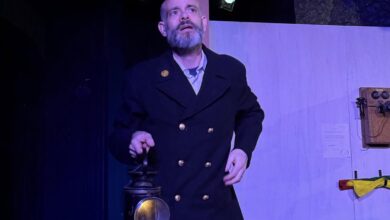Review: People in Cages, Drayton Arms Theatre
Come one, come all to a truly eerie showcasing of the human condition.Summary
Rating
Good!
What kinds of attractions would you pay to see? You may perhaps pay for a ticket at the cinema, or to go and see a popular tourist destination. But, would you pay to observe people in a cage? This is exactly the scenario which David Henry Wilson’s play People in Cages presents. In a written introduction, Wilson describes the notion of the cage as something that “has always struck me as a fertile image for countless aspects of the human condition.” The human condition itself is, then, at the centre of what this production explores.
People in Cages is a series of three different stories, performed in an absurdist style. From the dominant, giant cage placed on a red, black and white backdrop, and lighting which rarely changes outside of fading from one story to another, there is something uncanny about the set in general, which is then accentuated by the tales told, as if they were directly taken from a George Orwell novel.
The first, Killer in a Cage, is about a young couple, Mr and Mrs Smith (Joe Urquhart and Kaylah Copeland), who pay to see a man – as the title suggests – in a cage (John Kay Steel). A sign inscribed with the word ‘killer’ hangs from his enclosure. The couple is told by the caretaker, Mr Jacob (Finlay McLean), that they may communicate with the man but must stay a certain distance away from the cage for their safety. The couple is as intrigued by the man as he is by them, as they regard each other as remnants of an outside world.
Couple in a Cage then shows the same cage that once held the killer, but now the attraction is Mr and Mrs Grey (Steel and Jill Riddiford), who sit inside with nothing but a few drinks and a newspaper to keep them occupied. Meanwhile, Mr and Mrs Brown (Urquhart and Copeland) pay to observe and talk to the captives. The two couples regard one another through the lens of curiosity and envy, enquiring about each other. All the while, Mr Jacob ensures everything is going according to plan.
In the third story, four children sit in the cage as Mr Jacobs attempts to teach them, or rather brainwash them, into believing that he is in control of their lives. The caretaker tells the children things such as “In the beginning there was the word, and the word was Mr Jacobs.” The youngsters accept everything that he tells them, all except for Sam (Urquhart), who questions all the teachings.
These stories clearly reflect a deeper meaning about the social constructs of modern society. 21st-century Western standards might consider putting human beings in a cage to be cruel, yet the ‘cage’ which humans inhabit every day can be formed by many different causes and stress factors, such as feeling suppressed by social norms, peer pressure, work environments, the economy, politics, etc. The actors depict these aspects brilliantly, convincing the audience that they really are trapped within their respective cages and are desperately looking for a way out.
Wilson hopes that the production will be regarded as “a remarkable and original piece of considerable entertainment value”, but the play’s societal metaphors achieve rather more than that, raising questions about the human condition. The cage, along with the actors who pace both outside and inside, spotlights the most primitive aspects of our humanity and effectively discloses our innate desire for the freedom to be in control of our own lives, rather than feeling controlled.
Written by David Henry Wilson
Directed by Liz Carruthers
Designer Gülfem Ozdogan
People In Cages plays at The Drayton Arms until 19th July.







